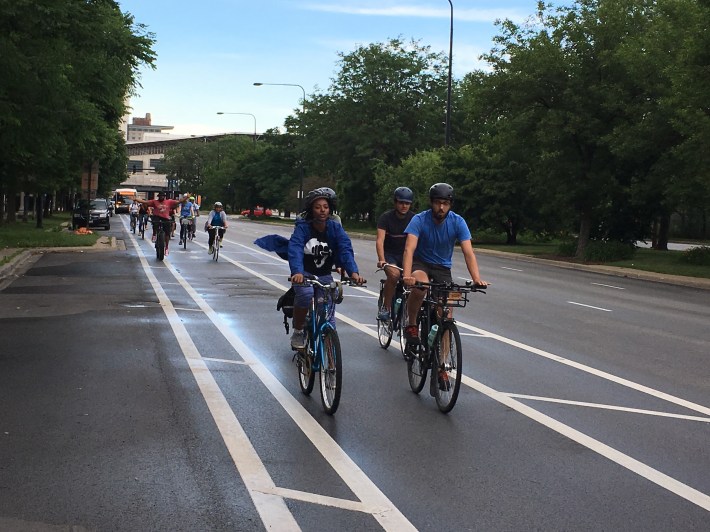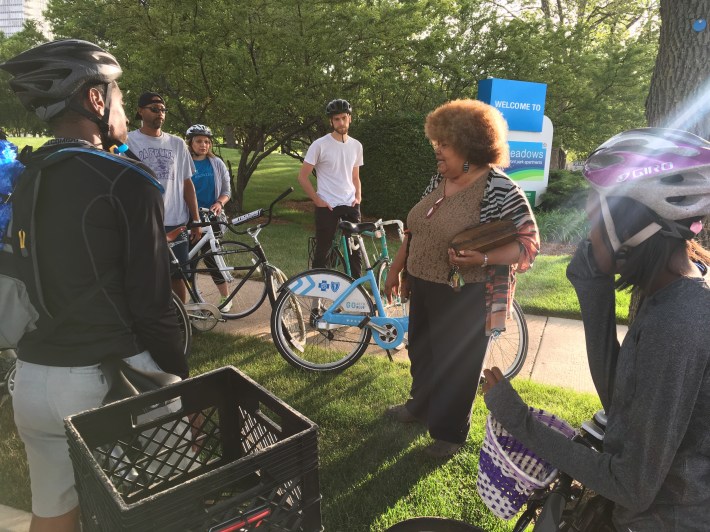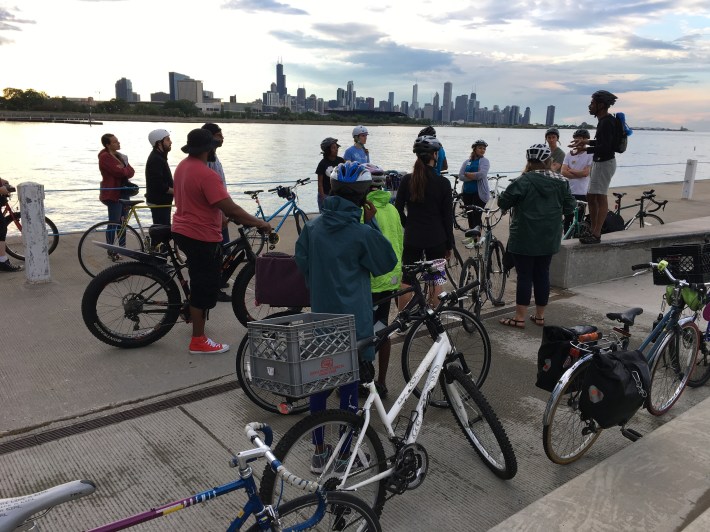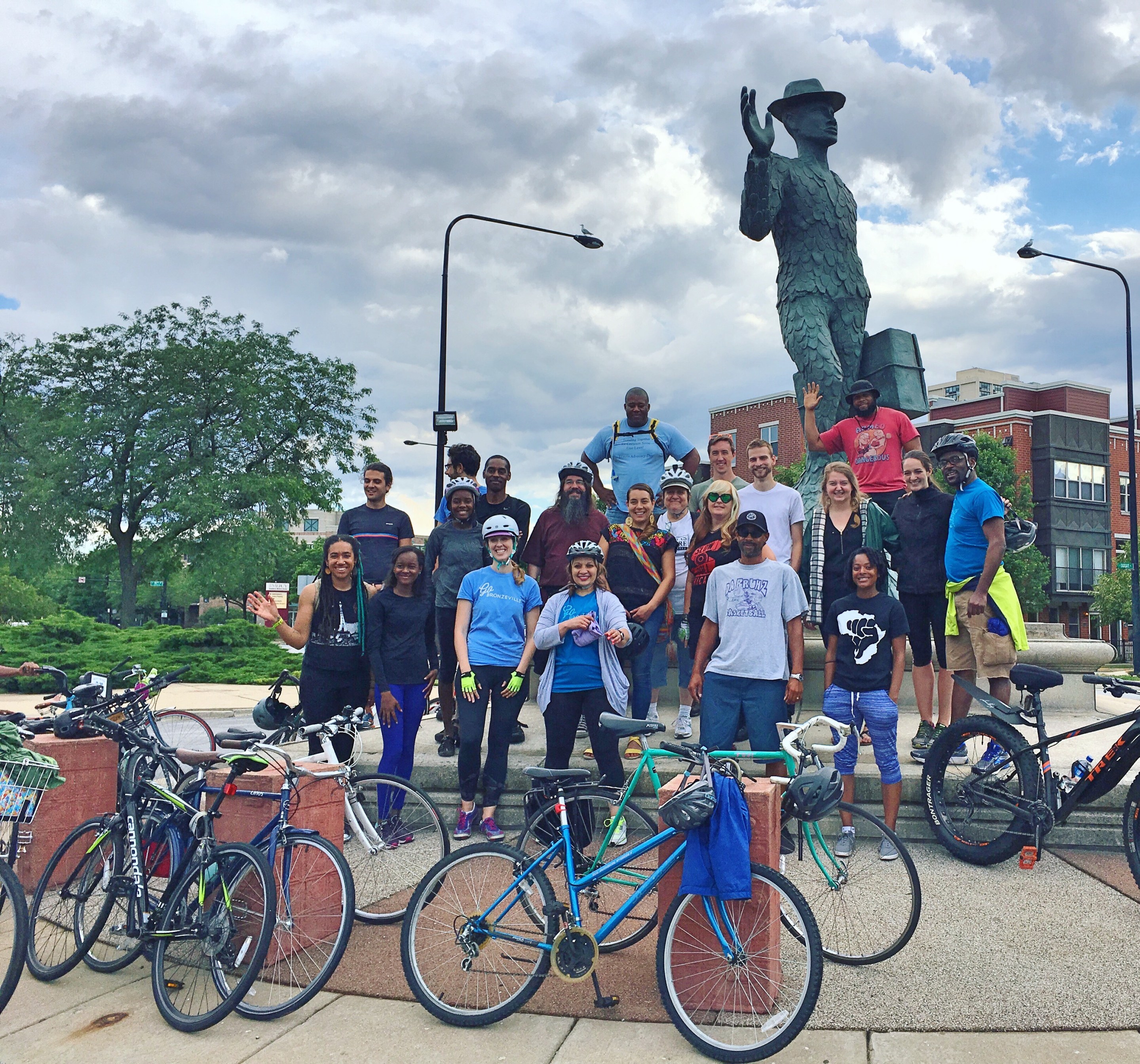Black lives on bikes matter, including those who came together this past Monday to ride and celebrate Juneteenth Day. A portmanteu of June and nineteenth, Juneteenth marks the momentous date of June 19th, 1865 when General Gordon Granger of the Union Army arrived in Texas to demand that the enslaved people there be set free. Due to its geographic isolation from the rest of the Confederacy, Texas was the last state to free its slaves. It was only after the Civil War ended that the Emancipation Proclamation was enforced by the Lincoln administration, ensuring that the enslaved were liberated.
Organized by Go Bronzeville and Slow Roll Chicago, the intent of the ride was to celebrate the significant impacts that Juneteenth and the Great Northern Migration have had on Chicago’s South Side and explore the “many varied opportunities that can be used to address the inequities that continue to plague those living in low-to-moderate income communities.” As for my intention, I was still energized from the Black Power Bike Ride, a pilgrimage to activist Ida B. Wells’ gravesite earlier this month, and was eager to learn if other cyclists believed there was a connection between cycling and Black liberation.
About 30 of us cyclists met up at Alison Saar’s “Monument to the Great Northern Migration” at 26th and King on the northern edge of the Bronzeville. While the group assembled, Waymond Smith, a seasoned rider from the South Shore neighborhood, enlightened the crowd about Saar’s monument and the largest migration ever to occur in North America. For Smith, the Great Northern Migration symbolizes “freedom from a severe oppression which destroyed generations of hopes and dreams.” He said his parents and grandparents escaped from the repressive Jim Crow laws in Mississippi and migrated to Chicago where they were able to “economically succeed beyond their wildest dreams.”

When I asked Smith if he thought Black people were free today, he replied that after being released from slavery, African Americans weren't given the proper resources to fend for themselves, laws were created to make it easy to incarnate Black people, and police are still killing African Americans today because of their skin color. “The legacy of slavery still exists, so we’re not really free,” he said.
The exodus of 6 million African Americans from the oppressive economic conditions in the south allowed Black folks to mobilize in the north and create a new culture of resistance. But today African Americans, along with other marginalized groups, continue to be economically enslaved by white supremacy, an institution that is upheld through inequitable public policy and urban planning.
After departing from Saar’s Monument, we further explored the history of the Great Migration as we rode throughout Bronzeville. Riding in Formation down South King Drive, we pedaled over to 31st and Rhodes to listen to Paula Robinson talk about the formation of Bronzeville, also known as the Black Metropolis, in the early 20th Century. Robinson is president of the Black Metropolis National Heritage Area Commission, which hopes to preserve the “unique landscape and assets” of the neighborhood by securing a federal NHA designation.

“From 1916 – 1970 roughly one million African Americans migrated to Chicago, moving into neighborhoods like Bronzeville, creating a city within the city,” Robinson told us. The first wave of migration brought with it southern musicians, serving as a catalyst for the creation of groundbreaking jazz, blues, and gospel music. The Great Migration also brought luminaries like Ida B. Wells and poet Gwendolyn Brooks to Chicago, creating a literary, artistic, and intellectual movement, similar to the Harlem Renaissance, that helped integrate Black and white cultures in the north and helped set the stage for the Civil Rights Movement of the 1950s and ‘60s.
As we continued with our critical history lesson to 31st Street Beach, I asked Bronzeville resident Lillian Webb for her perspective on bicycling, Black liberation, and the potential connection between the two. Two years ago Webb began riding bikes in chicago via the Divvy bike-share system. She recently purchased her own bicycle and is excited to go on more long-distance rides in the city. For her, the significance of Juneteenth is to celebrate the joy that the enslaved people in Texas must have felt when they received word of their freedom.
“This Juneteenth ride and the Great Migration points to the importance of mobility in terms of striving for freedom,” Webb told me. “Bicycling can be used as a tool of mobility that's fairly low cost that can take you fairly far.” She added that “there's all of these ways in which mobility has been used against Black people and Africans in the diaspora, from taking us from our homeland and keeping us enslaved, to keeping us from seeing the same economic opportunities that other races were allowed.”

I too was beginning to understand the huge role mobility plays in the fight for access to social and economic opportunities for marginalized groups. I was also beginning to understand the importance of city infrastructure and its connection to liberation.
Nearing the end of our ride, we gathered at one end of the newly constructed 35th Street Bridge where we listened to Slow Roll’s Jamal Julien highlight the connection between infrastructure improvements and community wellness. “What research has demonstrated is that when you have more walkable, bikeable, liveable communities, those communities have more access to fresh food, recreation, and quality education, leading to more parity and equity,” Julien said. When residents are able safely and conveniently walk, bike, or take public from point A to point B within their own community, it empowers them to support locally-owned businesses and helps make the community self-sufficient.
The concept of freedom has been debated for millennia by philosophers. Generally, freedom has been defined as “the ability to do as one wills and what one has the power to do.” In other words, freedom is about having the levers of control in one’s own hands. Ever since the first enslaved Africans were brought to Jamestown, Virginia, in 1619, the vast majority of Black Americans were not legally in control of their own lives, and Juneteenth celebrates the freedom that was finally granted 246 years later. Freedom today, however, has evolved to become intrinsically linked to our socioeconomic status. The more money we possess, the more ability we have to do the things we want to do.
This Juneteenth ride explored the concept of mobility being used as to tool by marginalized groups to improve their socioeconomic status. The Great Migration offered 6 million African Americans the opportunity to move away from the economic injustices they faced in the south to a new locale that allowed them to pursue new economic prospects, while granting them more power to envision and build a better future for their children.
Different modes of transit can serve as tools for mobility that can be used to empower and liberate communities that are still facing restrictive inequities. For example, an efficient transit system or safe bike network makes it easier for those seeking employment to access a job interview on the other side of town.
“A community that walks, bikes, and uses public transportation, is more economically viable, safer, and healthier,” said Go Bronzeville’s Ronnie Matthew Harris at the end of the ride. “The disparities in our health could be addressed if we just got out and rode.”
Bicycling can be used as a means to improve health, to save money, and to reduce the air pollution that disproportionately affects African Americans, so it is an effective tool for Black liberation. That is why Black lives on bikes matter.





